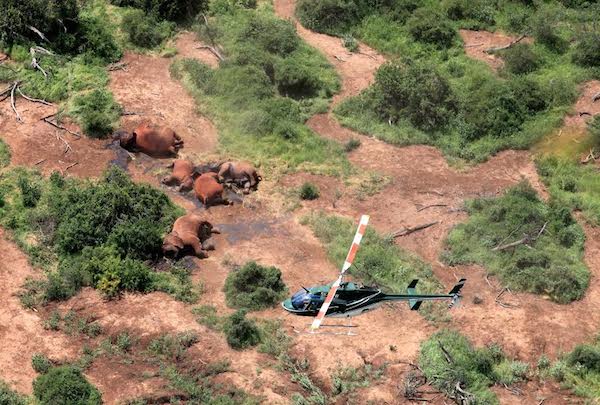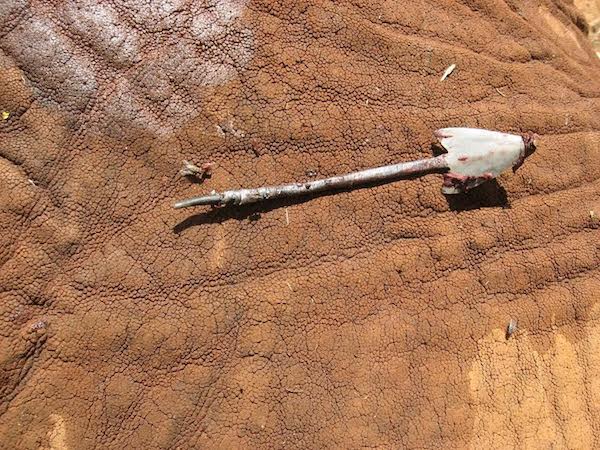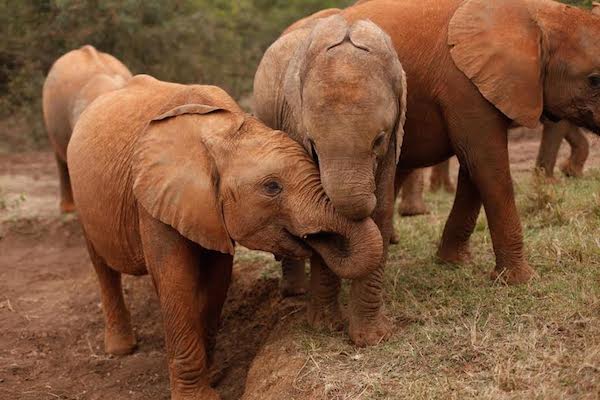A living African elephant has 76 times the value of one poached for ivory, according to report
Elephants are worth 76 times more when they’re alive than dead, according to a new analysis released this past weekend. The report follows on the heels of findings by WWF that the world has lost 50 percent of its wildlife over the past 40 years, with more than half of African elephants killed for ivory in just one decade.
The analysis, conducted through the David Sheldrick Wildlife Trust’s iworry campaign, compared the value of elephants to local economies to profits netted through the illegal ivory trade. Between January and August 2014, researchers tallied approximately 17.8 metric tons of ivory seized worldwide, harvested from 1,940 poached elephants. Most of these seizures occurred in Kenya, Gabon, China, and Vietnam, countries identified by CITES as doing relatively little to stem the tide of black-market ivory.

Anti-Poaching Teams with seized ivory. Photo courtesy of The David Sheldrick Wildlife Trust.
In their report, iworry estimated the raw-ivory value of a poached elephant to be $21,000. In contrast, a living elephant is worth more than $1.6 million over its lifetime, largely because of its eco-tourism draw. The report lists travel companies, airlines, and local economies as benefitting from this largess of the world’s largest land mammal, whereas the ivory trade may fund criminal and terrorist groups.
“The value of elephant tourism is extremely high, with a living elephant worth a shocking 76 times more alive in the savannah than in the market place,” said Rob Brandford, iworryc ampaign director. “Protecting Africa’s elephants makes monetary sense and in the long term elephants are worth more alive roaming the world’s savannah and forests than their tusks are sitting on a mantle. That’s a powerful argument to convince policy makers.”
The seizure of 17.8 metric tons of ivory is likely just a drop in the bucket. The report states that developed countries intercept only about 10 percent of contraband good such as ivory, meaning that up to 178 tons of ivory may have been trafficked this year—the result of 19,400 elephants killed.

Family of 11 poached elephant carcasses, Tsavo Jan 2013. In Tsavo, poachers favor silent methods of poaching including spears and poisoned arrows. Photo courtesy of The David Sheldrick Wildlife Trust.

An arrow recovered from an elephant targeted by poachers. Photo courtesy of The David Sheldrick Wildlife Trust.
Before the advent of plastic, ivory was commonly used to make cutlery handles, piano keys, and other consumer goods with. While some of the global demand for ivory was satiated with the dug-up tusks of extinct mammoths, more often it was sourced from living animals. Numbering between three and five million in the 1930s and 1940s, global ivory demands for consumer goods decimated African elephants (genus Loxodonta) throughout Africa, with the continent’s entire population halved during just the 1980s. Some populations of elephant have declined more than others, with Chad’s elephants declining from 400,000 in 1970 to 10,000 in 2006—or more than 97 percent.
In response to the massive decline, CITES banned international trade in ivory in 1989, eliminating major ivory markets and slowing decline. However, declines still continue, and scientists estimate 23,000 African elephants were killed for their tusks in 2013 alone. The driving force behind the killings is high demand from East Asian countries, such as China.
The report’s authors hope its findings spur action and provide added incentives for elephant protection.
“These findings aren’t definitive but they are shocking and make it clearer than ever that we must recognize the value of our wildlife and environmental heritage in order to pass policies that safeguard against their destruction,” Brandford said. “Referring to wild animals as economic commodities has created controversy in the past but where policy is determined by the value of an object, it’s time to give the elephant a fair footing.”
According to the report, the slaughter of elephants so far this year has amounted to an economic loss of more than $44.5 million.
“In order to secure the long term future of the species, it is vital Governments understand the tangible benefits elephants can bring,” Brandford said. “Given the overlap of ivory poaching locations and elephant tourism operations, every elephant killed makes these regions much less profitable.”

An elephant is treated for poaching wounds. Photo courtesy of The David Sheldrick Wildlife Trust.

Ivory stockpile recovered from poached elephants. Photo courtesy of The David Sheldrick Wildlife Trust.

Orphaned elephants cared for at an orphanage in Nairobi, Kenya. Photo courtesy of The David Sheldrick Wildlife Trust.
Related articles

(09/30/2014) On Monday, September 22, two ivory poachers were arrested in Mozambique during a late-night raid near Niassa National Reserve. The arrest followed on the heels of nearly two-dozen reported kills in the reserve in just the first two weeks of the month.
WCS-led raids lead to six arrests near Mozambique’s largest reserve

(09/12/2014) A joint force of the Wildlife Conservation Society (WCS) and government authorities are in the midst of carrying out a series of raids against poachers in Mozambique aimed at halting the illegal killing of elephants in Niassa National Reserve, the country’s largest protected area. Six men, thought to be responsible for killing 39 elephants in 2014, were arrested in an early morning bust in the town of Marrupa, just south of the park.
Elephants pay the price for palm oil in Malaysian Borneo, impact may reach far beyond reported kills

(09/10/2014) More than a dozen elephant kills were reported in Sabah in 2013 alone, but it is unknown exactly how many have lost their lives in recent years as palm plantations encroach further and further into the rainforest. What is clear is that if the loss of their forest habitat continues to drive conflicts with humans at the rate it is now, Borneo elephants’ long-term survival may be in jeopardy.
Zambia ends trophy hunting ban, elephants fair game
(09/09/2014) After 20 months, Zambia has lifted its ban on hunting, allowing trophy hunters to target numerous species in the wildlife-rich country including elephants. The announcement was made by the country’s Tourism and Art’s Minister, Jean Kapata, who stated that the ban had resulted in a loss of revenue to the Zambia Wild Life Authority (ZAWA).
20 percent of Africa’s elephants killed in three years

(08/19/2014) Around 100,000 elephants were killed by poachers for their ivory on the African continent in just three years, according to a new paper in the Proceedings of the National Academy of Sciences. Between 2010 and 2012 an average of 6.8 percent of the elephant population was killed annually, equaling just over 20 percent of the continent’s population in that time.
Elephant poaching soars as Sumatran forests turn into plantations

(08/14/2014) There has been a spike in elephant deaths in Sumatra this year, and conversion of rainforest to plantations is one of the main causes. The number of Sumatran elephants poached in the province of Riau so far this year is staggering, with 22 reported kills in the first six months of 2014 compared to 14 for the entirety of 2013.
Jane Goodall: how many elephants will be killed on World Elephant Day?
(08/12/2014) Marking World Elephant Day, a designation intended to raise awareness about the plight of elephants that are being widely poached for the ivory trade, primatologist Jane Goodall urged people to have greater compassion for Earth’s largest land animals.
Want to save Africa’s elephants? Close all ivory markets

(08/07/2014) The only way to save the long-suffering elephants of Africa is to close every ivory market on the planet and destroy all ivory stockpiles, according to a bold new essay in Conservation Biology. Written by Elizabeth Bennett, the Vice President for Species Conservation at the Wildlife Conservation Society, the paper is likely to prove controversial.
New Jersey bans elephant ivory trade

(08/05/2014) New Jersey Governor Chris Christie has signed into law a ban on elephant ivory sales, reports NorthJersey.com. The measure, passed earlier by the New Jersey State Senate and Assembly, establishes fines for first-time offenders caught buying or selling ivory products. Repeat offenders have stiffer fines.